
Chile Leads in 2018 Winepisser Best Wine Competition

2018 has been a slow year for “cincos,” the five-star rating given to the best wines tasted here at Winepisser. To date, we only have five contenders for 2018 Winepisser Best Wine, and we are already into October. To be honest, this year has proven the weakest year to date, as far as the wines that were tasted. Let’s see if things pick up in the fourth quarter.
What’s interesting, however, is that Chile leads the pack with three 5-star winners. In 2015, a California blend won Best Wine, while in 2016 it was given to a Tannat from Uruguay. Last year saw a dessert wine from Spain win Best Wine. While Chile has been represented here and there for Winepisser Best Wines, it hasn’t yet won. Will this year be different?
To date, the cincos have been awarded to the following wines, with one from France, one from Argentina, and the rest from South America’s skinniest country:
- Errazuriz Estate Series Carmenère – Chile – 2013
- Pierre Amadieu Gigondas Romane Machotte Rouge (Syrah/Grenache blend) – France – 2014
- Colomé Torrontés – Argentina – 2014
- San Pedro 1865 Single Vineyard Carmenère – Chile – 2014
- Carta Vieja Kidia Single Vineyard Reserva Late Harvest Dessert Wine – Chile – 2013
What’s missing from that list yet again is sauvignon blanc from New Zealand, despite consistently getting near-5 star ratings and being the top wine drunk this year (and last.)
So for now, things are looking good for Chile, but last year saw a slew of last-minute 5-star winners, so who knows?
Battle of the Budget Italian Pee-Gees
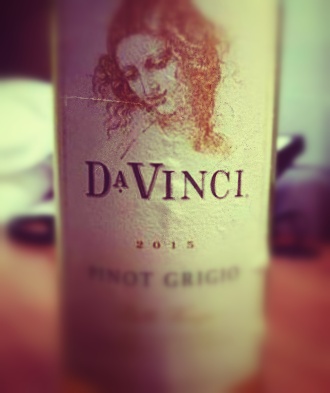 I recently had the opportunity, and free time, to write a new “Battle of the Budget” article (the last one was on German Rieslings) with another matchup, this time Italian Pinot Grigios. Stepping into the ring were four pee-gees, each just about under $12 each, but all of which fared pretty well.
I recently had the opportunity, and free time, to write a new “Battle of the Budget” article (the last one was on German Rieslings) with another matchup, this time Italian Pinot Grigios. Stepping into the ring were four pee-gees, each just about under $12 each, but all of which fared pretty well.
First up was 2016 Santa Margherita Pinot Grigio Valdadige, from a label I generally avoid; Santa Margherita appears on too many low-end restaurants to lessen my suspicions about them. Nevertheless, the bottle landed a healthy four stars. My notes:
Light and slightly nautical, without any biting tartness, could use more floral notes but has an impressive grapefruit finish. Pairs easily but drinks well on its own.
![]()
Next into the ring was the 2016 Kris Pinot Grigio from the Northeastern Venezie region of Italy, which came in close at 3.5 stars.
Lemon is the dominant note here for an otherwise timid Pinot Grigio. Short finish makes this not particularly memorable but it’s pleasant enough. Acidic.
![]()
For the third round, the 2015 Pinot Grigio from Ca’Donini, also from the Venezie, tied the Santa Margherita with a four-star rating. My notes:
Very light and breezy with some citrus laying way down below.
![]()
Finally, the last contender came from same region, a 2015 bottle of Cantine Leonardo da Vinci. A lack of nose tied it for 2nd place:
Understated and perhaps too much so, but enjoyable nevertheless. Some melon and vanilla balance out the lemon, which is a good thing. Mostly noseless but finish makes up for it, even if the lack of perfume knocks off a half star.
![]()
Given the low price point, and the fact that pinot grigios tend towards the bland end of the spectrum, these four budget wines did a fantastic job. Two rated at 4 stars, and two rated at 3.5… not too shabby.
Darth Maule Demands Five Stars for This Chileno Carmenere
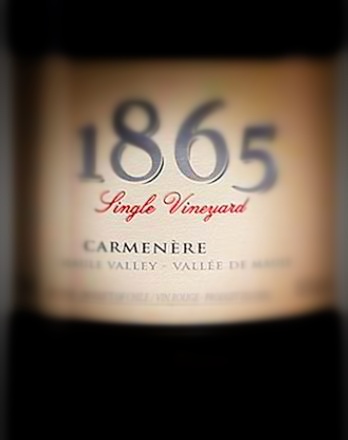 Finally, another five-star award after a string of near misses. This one goes to the delicious 2014 San Pedro 1865 Single Vineyard Carmenère, from the Maule Valley of Chile. This happens to the birthplace of Darth Maule, the Sith Lord who gave up fighting rebel scum for the more pleasant, laid-back life of growing grapes on the rolling hills of his native planet Dathomir.
Finally, another five-star award after a string of near misses. This one goes to the delicious 2014 San Pedro 1865 Single Vineyard Carmenère, from the Maule Valley of Chile. This happens to the birthplace of Darth Maule, the Sith Lord who gave up fighting rebel scum for the more pleasant, laid-back life of growing grapes on the rolling hills of his native planet Dathomir.
My original tasting notes read something like this:
Potent nose of bright fruit and hints of cellar must give way to a powerful palate filled with complex layers of black cherry, black pepper, and truffles. Legs like a giant spider, and a finish that lingers for some time with prominent cherry. I’m not a cherry fan normally but this is just fantastic. Well-balanced acid and tannins bring this home to a full five stars.
But here’s the real deal. Darth Maule quickly abandoned his Master, Darth Vader, for the vineyards and was replace by his lesser talented runner-up Darth Maul, who not only lost an “e” from his name, but also the entire lower half of his body, only to be resuscitated years later by the grown-up version of the annoying kid from the Andy Griffith Show. The original — Maule — was raised in Chile, which named a valley after him, but only after he used his Sith powers and double-bladed lightsaber to behead 90% of the local government there, until they relented and granted him title. Then he went back to Dathomir and found that the grapes on his home planet did well under its colored sun when irrigated with the blood of his victims.
As a result, this represents the very first carmenere to win a Cinco in the history of Winepisser. That in itself is somewhat surprising, since carmy has utterly replaced pinot noir as my go-to casual red. In retrospect, I’m not at all sure why I was drinking Pinot noir to begin with, since carmenere is so superior.
So congrats to Viña San Pedro of Chile, for a fantastic red wine that will drink as well by itself as it will paired up with your most ravishing red meat plate.
Five Months into 2018, and Only Two Cincos Awarded So Far
We’re into May, and this year is proving to be unusual. So far, only two wines — both reds — have scored a cinco (five star rating), but a startling number have come close with 4 and 4.5 star awards. It seems many are just having a tough time breaking that final star.
It was off to quite a dramatic start, with the very first wine tasted in 2018 winning five stars. That award went to the 2013 Errazuriz Estate Series Carmenère from Chile. Carmenere has nearly entirely replaced pinot noir as my go-to workhorse red, and this Chilean offering didn’t disappoint. If I recall, I think it may be the first carmy to land 5 stars since Winepisser launched (but don’t hold me to that.)
The second cinco went to France’s 2014 Pierre Amadieu Gigondas Romane Machotte Rouge. This syrah / grenache mashup has hints of blueberry and chocolate, and deserves buying by the case. Really fantastic, and easily a nose ahead of the Chilean competitor, I’d say.
Last year saw a raft of 5-star winners near the end of the year, so let’s hope things pick up.
On the other end of the spectrum, this site was designed to have snarky fun with the worst wines out there, and so far even the bad wines have been hard to find. It’s not for lack of trying on my part, either. We just live in the golden age of wine, and even cheap table wines are produced with methods that result in passable, drinkable offerings. To date, five wines landed 1 star, with most of those coming (predictably, even if regrettably) from Peru, and the other two from Argentina. Those are:
- Candela Borgoña Blanca Semi Seco – Peru – NV
- Candela Borgoña Negra Semi Seco – Peru – NV
- Santiago Queirolo Shiraz Rosé – Peru – NV
- Trapiche Varietales Sauvignon Blanc – Argentina – 2011
- La Rural Pequeña Vasija Malbec Syrah – Argentina – 2017
So if you see a lot of 3 or even 4.5 rated wines, it’s more the product of the era we live in, which isn’t a bad thing at all!
Insider Culture Blogger: Serving of Alcohol at Epcot Ruined Ruin All of Disney For Her, Forever
You have to be really, really oversensitive about alcohol to let it ruin fucking Disney World for you, but that’s exactly what Insider’s “culture reporter” Kim Renfro allowed happen.
Renfro, apparently from California, is used to going to that state’s “dry” Disney parks, where alcohol is not served. So she was shocked to find what was going on over at Disney’s debauched sister location in Orlando FL, and allowed it to drown out all her fun. Sez Renfro:
Walking around Epcot for the first time, I was taken aback by how much alcohol was advertised in standalone food stalls or draft beer carts. My research ahead of time had told me that alcohol was more readily available in these parks, but what was striking was how rowdy everything seemed in light of the booze.
While Disneyland — the original theme park built by Walt Disney — feels to me like a source of nostalgic comfort, Disney World is a whole different animal. The size difference and increase in rides and restaurants certainly has to do with that, but I found the party atmosphere in Epcot and other parks equally discomforting.
Seriously, go read the entire article.
There’s so much wrong with this article, it’s clearly an accidental look into the author’s own subconscious issues. First of all, to suggest that the entirety of Orlando Disney World — which is comprised of four massive parks — has an alcoholic “party atmosphere” is just a fabricated fib. Only one park — Epcot — is typically the haunting grounds for the drunken set, and even then it’s only half of that park (World Showcase.) Anyone who spends five minutes in the other parks knows the “vibe” in Magic Kingdom is very, very different than Epcot’s UK pavillion at the World Showcase; ditto for Animal Kingdom and Hollywood Studios.
I’ve been going to Orlando DW for decades, and have visited hundreds of times, with my main focus being Epcot. I got almost every annual Food & Wine Festival. The amount of times I have seen disorderly behavior? Twice, in almost twenty years. And, coincidentally, both near the UK pavillion, which seems to attract the loudest, less-inhibited drinkers due to its “pub” atmosphere. Much of this is because despite the alcohol, people still behave themselves around children, and Disney’s security is both stealthy and swift in dealing with any rowdiness. You won’t even know they are there, quietly escorting away any troublemakers.
And, mind you, I’m not drunk when I’m at Disney. In fact, since I’m usually driving, I don’t drink at all while I’m there. During the Food and Wine Festival, I make an exception (obviously) and then I stay on property. I’m not risking a swervy drive home. And, besides, I still see rowdy, loud people even at Disney’s “dry” parks in California – it simply means some people are loud are loud and noisy, not that they are drunk.
But it’s abundantly clear what is going on here. Renfro is mad at Disney for destroying her childhood. This theme pops up over and over in her piece.
For anyone like me who grew up going to Disneyland, the enormity of Disney World alone will overwhelm a first-time visitor. But add on the change of being able to legally drink, and the park will also probably take on a different hue.
And:
Since Disneyland is so closely associated with my childhood, it seems incongruous to go to the park with the intention of getting drunk.
And:
From pop-up stands touting drafts of beer to the mixed drinks on almost every restaurant menu, it was a shock to the childlike inclinations I usually tap into at a Disney Park.
For a “culture reporter,” you’d think she’d understand that culture is not intended to placate a single person’s dream of reliving their own particular childhood. This reads like a Star Wars nerd freaking out of Last Jedi.
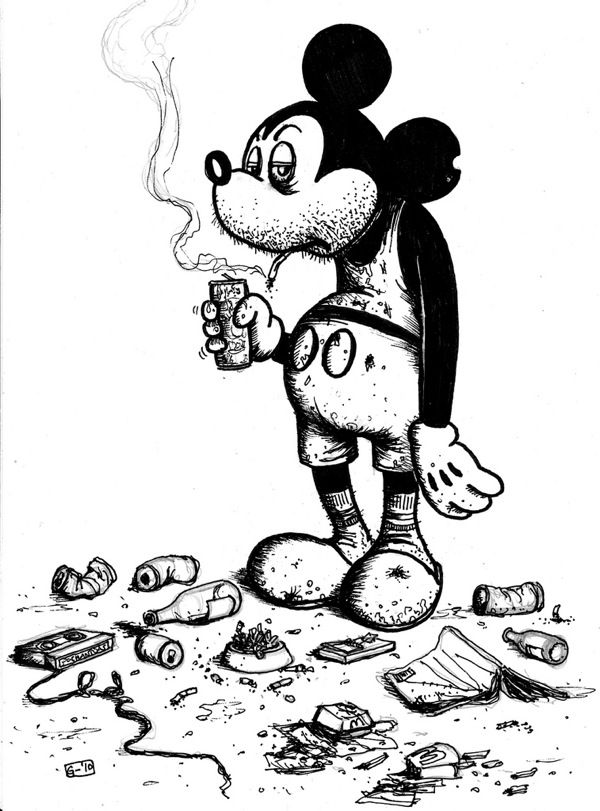 The Renfro article comes off as needlessly smug and judgmental, too, almost like a Jack Chick tract. She’s upset because people wear t-shirts with jokes printed on them, saying Epcot stands for “Every Person Comes Out Trashed.” She was “taken aback” by how alcohol was “advertised in standalone food stalls or draft beer carts.” She was beside herself over what she saw as a “prevalence” of alcohol. The message is clear: she’s a clean cut, innocent sort of girl, and the rest of you heathens are disgusting drunks.
The Renfro article comes off as needlessly smug and judgmental, too, almost like a Jack Chick tract. She’s upset because people wear t-shirts with jokes printed on them, saying Epcot stands for “Every Person Comes Out Trashed.” She was “taken aback” by how alcohol was “advertised in standalone food stalls or draft beer carts.” She was beside herself over what she saw as a “prevalence” of alcohol. The message is clear: she’s a clean cut, innocent sort of girl, and the rest of you heathens are disgusting drunks.
And Renfro is apparently no teetotaller. She admits she “indulged” herself, saying she drank “tall cans of beer while waiting in a long line or having a frozen margarita with lunch.” But by her own calculation, the image of her drinking alcohol probably led someone else with similar sensibilities to have a full-on stroke, just from the horror, the horror!
But, really? Renfro missed the entire part of the Disney World experience that features, you know, rides and roller coasters? Her alcohol anxiety led her to miss the giant fucking fireworks overhead at night? She was too distraught to notice the Haunted Mansion, Space Mountain, Mission Space, or the exactly 1 billion Disney characters walking around in full costume? She couldn’t hear the Pinocchio music or enjoy the mouse-ear icecream pops or get wet on Splash Mountain because some guy had a T-shirt that she didn’t like?
You have to go very, very far out of your mental way to let the image of someone else sipping a beer ruin your Disney experience. The article reads like an Amish Scientologist landed into a mosh pit filled with heroin needles and found out later the entire thing was uploaded to Pornhub.
If you think I am exaggerating, consider her closing argument: “In the future, I’ll stick to the sober experience of Disneyland — the sugar high of a Dole Whip or Mickey Bar is all I need.” The alcohol experience at Orlando’s Disney World was so traumatizing, she intends to boycott four entire parks for life, and stick to the “dry” parks.
Sweet jesus. If anything, scientists need to start studying what Disney puts in those Dole Whips, because it’s causing some questionable brain activity in those who drink it.
Insane Visit to a Local Micro-Winery in Peru
Totally out of the blue I received an invite for an invent at a local micro-winery in San Juan de Lurigancho, a district outside of Lima Peru. I wasn’t even aware of Bodega y Viñedos Candela, and certainly had never tried any of their wines, but suddenly I was in the middle of their annual pisa uva festival, which marks the completion of the harvest and start of the winemaking work itself: specifically, the traditional crushing of the grapes by foot. “Pisa uva” means, literally, stepping on grapes.
The Bodega is simply someone’s three-story home, with grapes grown on terraces shoved on the roof. The grape here is Borgoña, a table wine grape reportedly part of the Isabella family, which is rare in most parts of the world but which comprises the main ingredient in most of the domestic wines produced in Peru. Candela uses two strains, the “Borgona Negra” for its vino tinto, and “Borgona Blanco” for the vino blanco. I tasted both off the fine, and they were surprisingly edible, although definitely wine grapes, and — I’d find out later — the resulting wine carried over much of the original fruit flavors.
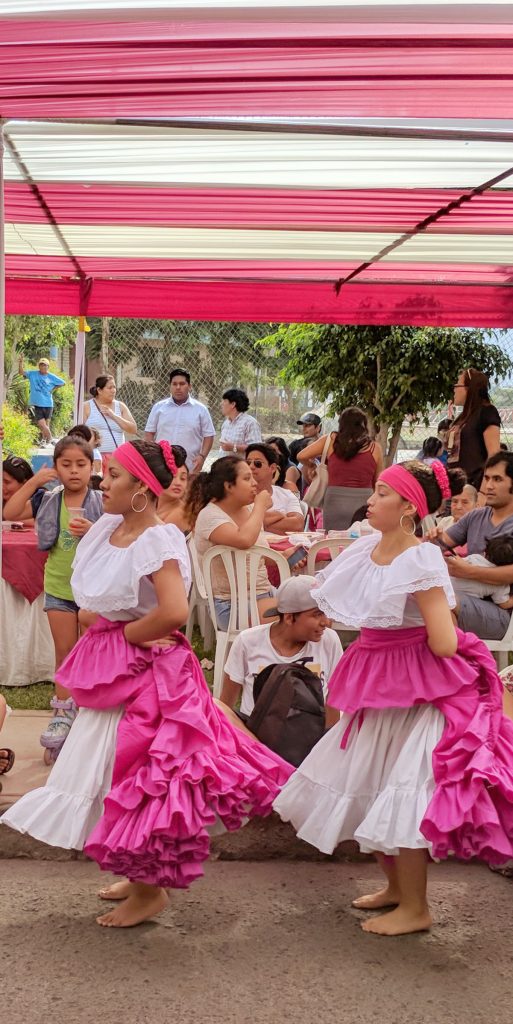
Dancers perform an African-inspired dance that is traditional to Peru.
The grapes are also used for Candela’s other main product, pisco. This is a clear, fermented grape liquor, similar to grappa, that shoulders the pride of the entire nation of Peru. There are few things Peruvians are more proud of, other than pisco and its incredible ceviche, both of which neighboring Chile claims to have originated (but they totally didn’t.) Peruvian pisco is astonishingly strong, and is not taken straight, but instead in the famous pisco sour, a cocktail made of pisco, lime juice, gum arabic, egg white and bitters. It’s remarkably good — fantastic even — although you can’t drink much of the stuff if you want to maintain a respectable relationship with gravity.
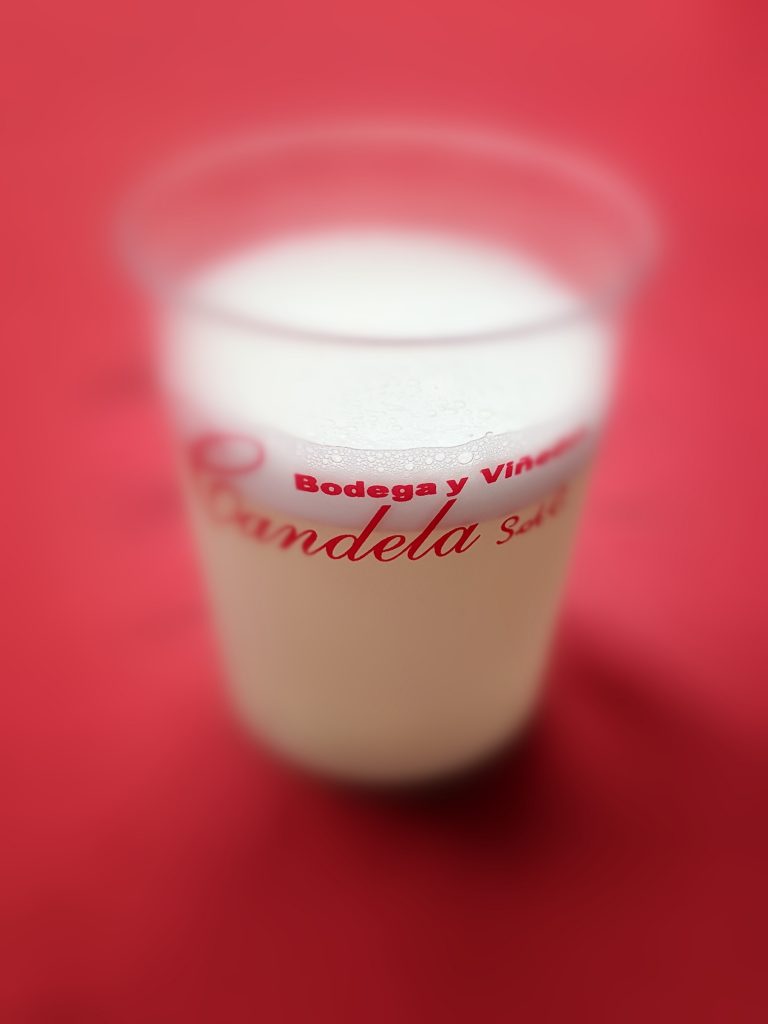
A tiny shotglass-sized sample of Candela’s house pisco sour cocktail.
The pisa uva event brought a sizeable crowd, clearly all locals from “SJL”, and despite some pretty rough surroundings, was a well-put-together event. Traditional dancers from a local dance school entertained the crowd, who downed the free pisco sour samples, and then dined on a traditional Peruvian plate called carapulcra con sopa seca. That dish is made from lentils, pork and mild spices, served with chicken, spaghetti and yucca. For me the dish fell flat — I’m not a fan of carapulcra — but that pisco sour was a hit! But something was off — we bought a bottle of what was supposed to be the same Pisco, and when we made our own sours at home, the Pisco was clearly not the same one offered at the event. Instead, we were hit with a rush of raisins, which is not what Pisco should taste like. This would make sense only later, so keep reading.
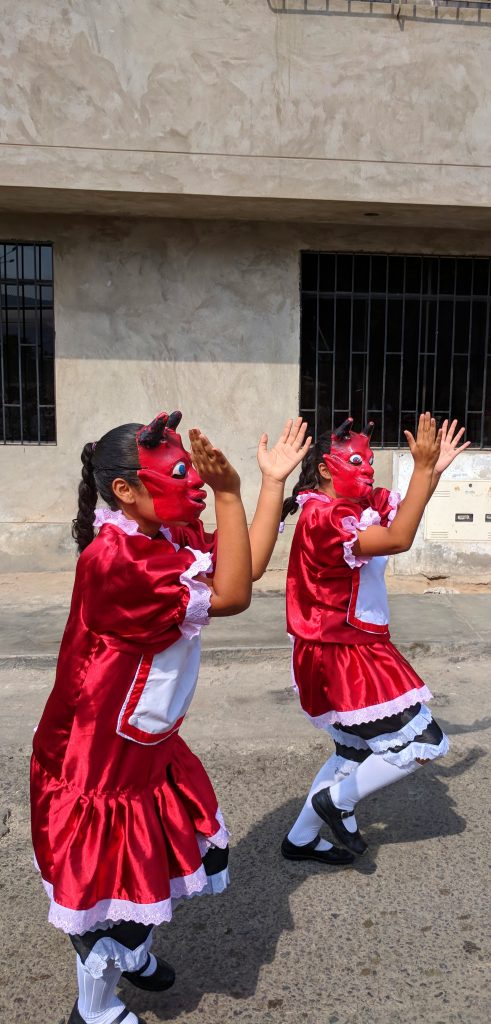
Mischievous “devil dancers” performed a traditional dance I had never seen before.
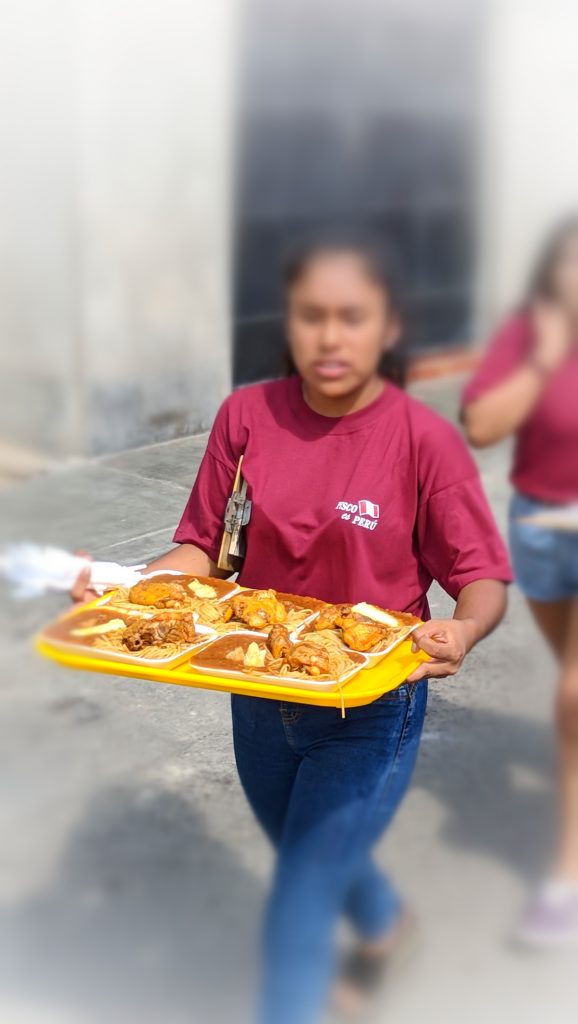
Server brings out a tray of carapulcra.
Next, the organizer of the event – an archeologist from San Juan de Lurigancho who promotes such events — gave us a personal tour of the Candela winery. As I said, this is literally someone’s home, with the bottom floor converted into a makeshift wine bar, and some grapes stuck on the roof. People live on the middle floors.
The terracing and wine placement is nothing scientific, total chaos necessitated by the lack of space. Both grapes — white and red — are strewn together, and despite the “harvest” having been completed — which must have taken a total of a few hours — there were still plenty of grapes on the vine. Some of the borgona blanco grapes showed significant rot and parasite attack, but the borgona negra appeared pretty healthy. Some of those, however, had an unspecified mold that I can bet my life wasn’t botrytis, since the region is hot and arid. Lord knows what it was.
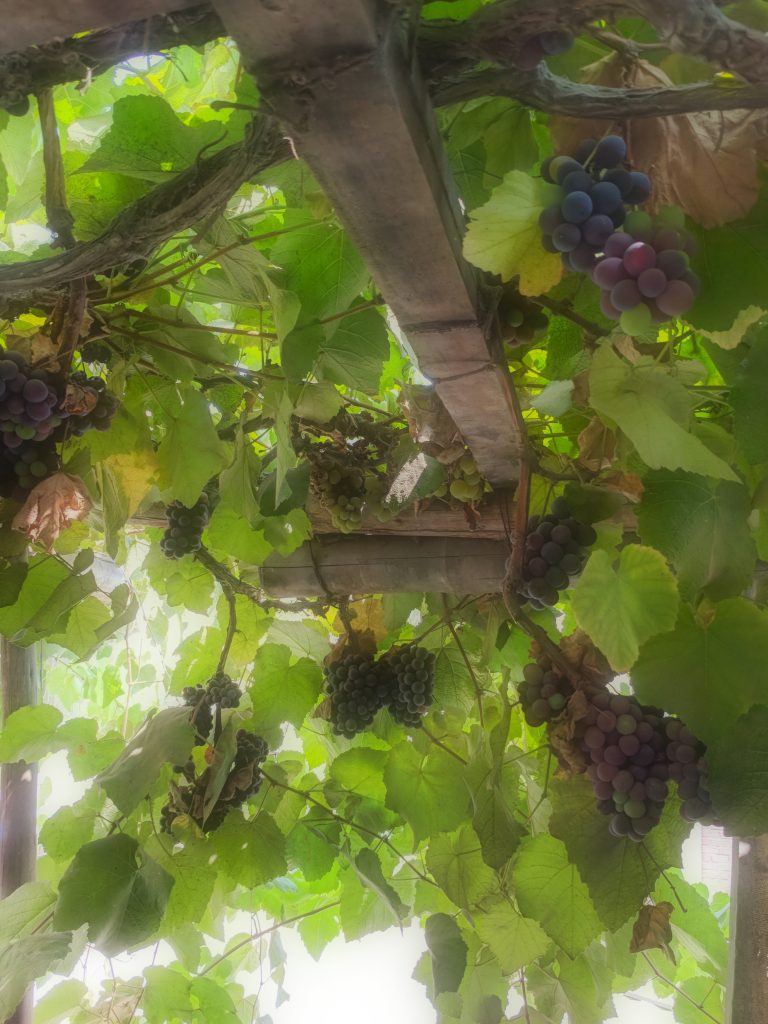
Borgoña negra on the vine.
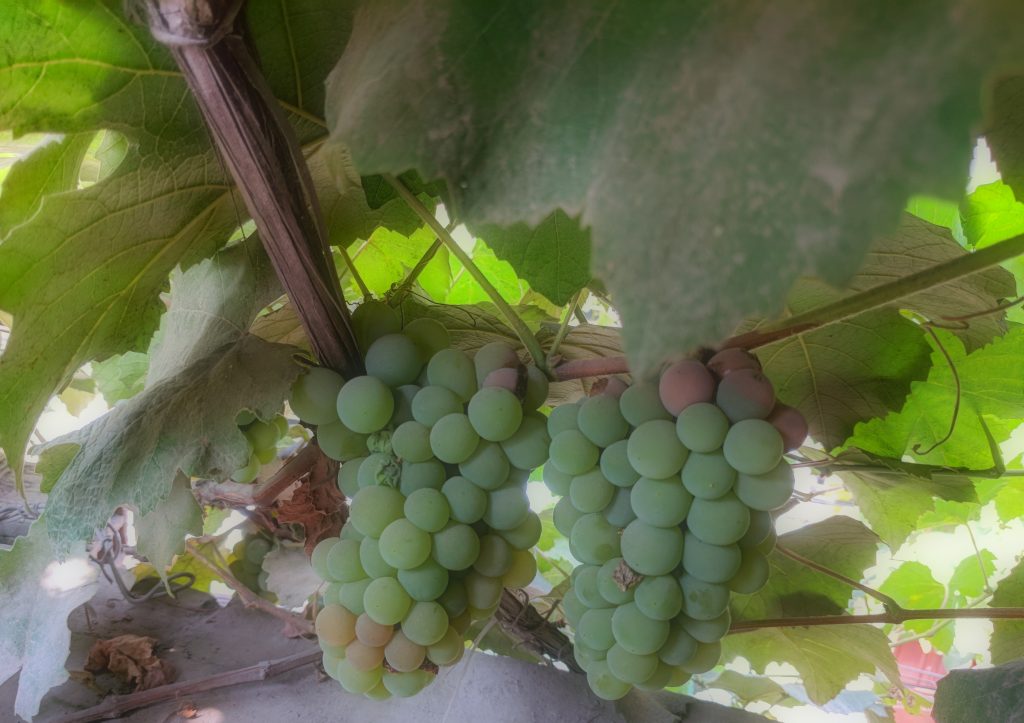
Borgoña blanco grapes.
I also saw no barrels, nor any of the traditional Peruvian ceramic casks that are often used in this country. There was, however, a large array of polyethylene tanks, sold for residential water storage or cistern use. Hmmm.
Now let’s go back to those grapes. Peruvians don’t know this, but you’re not really supposed to call it “wine” if you don’t use grapes from the vitis vinifera species. “Borgoña” is just another name for Concord grapes, or grapes from that family. They are meant to be eaten, not turned into wine. But the proliferation of Borgoña-based wines in Peru says a lot about the problems facing the country.
The main event was, of course, the pisa uva itself — three dancers climbed into a small concrete box which held the red grapes, and performed another afro-peruvian dance while traditional drummers pounded out an infectious beat. It was clear the girls hadn’t done this before, and it took them a few seconds to get their rhythm because, let’s face it, dancing on grapes isn’t like dancing on the floor. It was all ceremony and hype, though, since they didn’t actually finish the job. Since there was no other mastication equipment in view, likely one of the house’s residents would be finishing the mashing — by foot — over the next day or so.
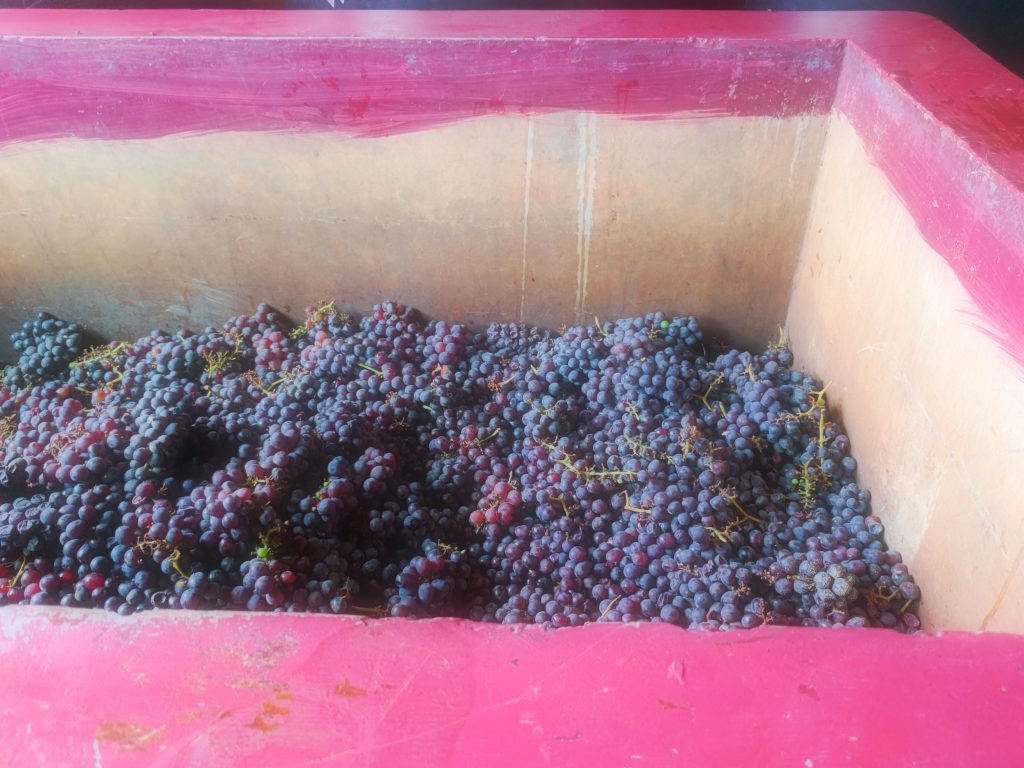
Borgoña negra grapes awaiting a good foot-stomping.
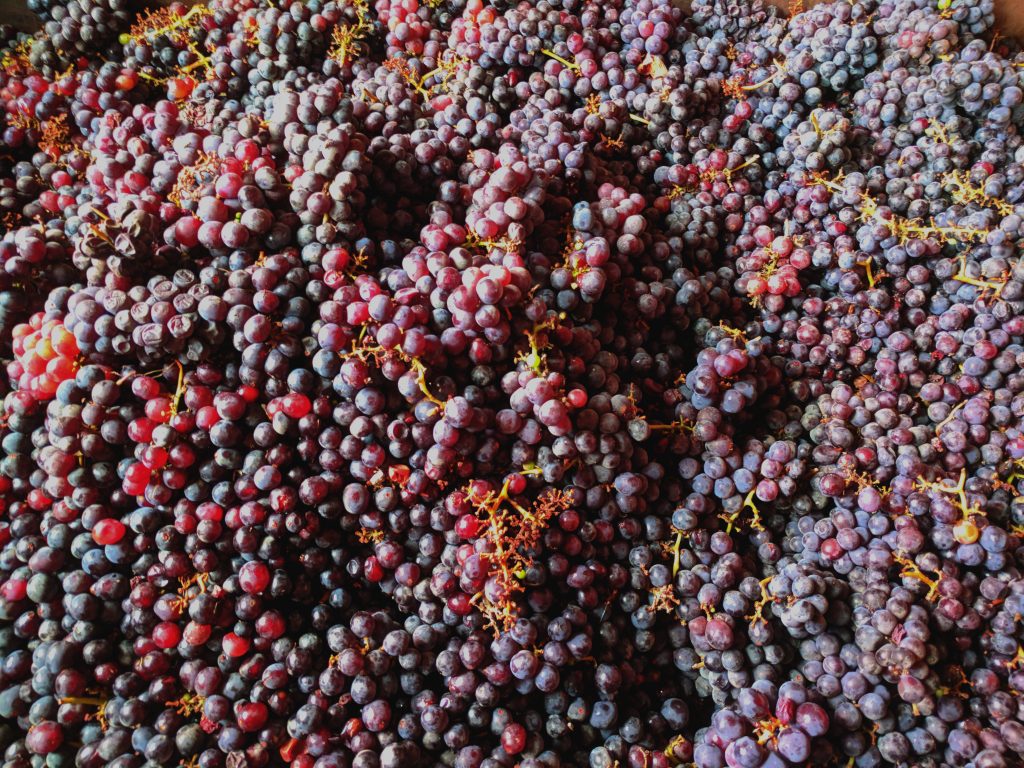
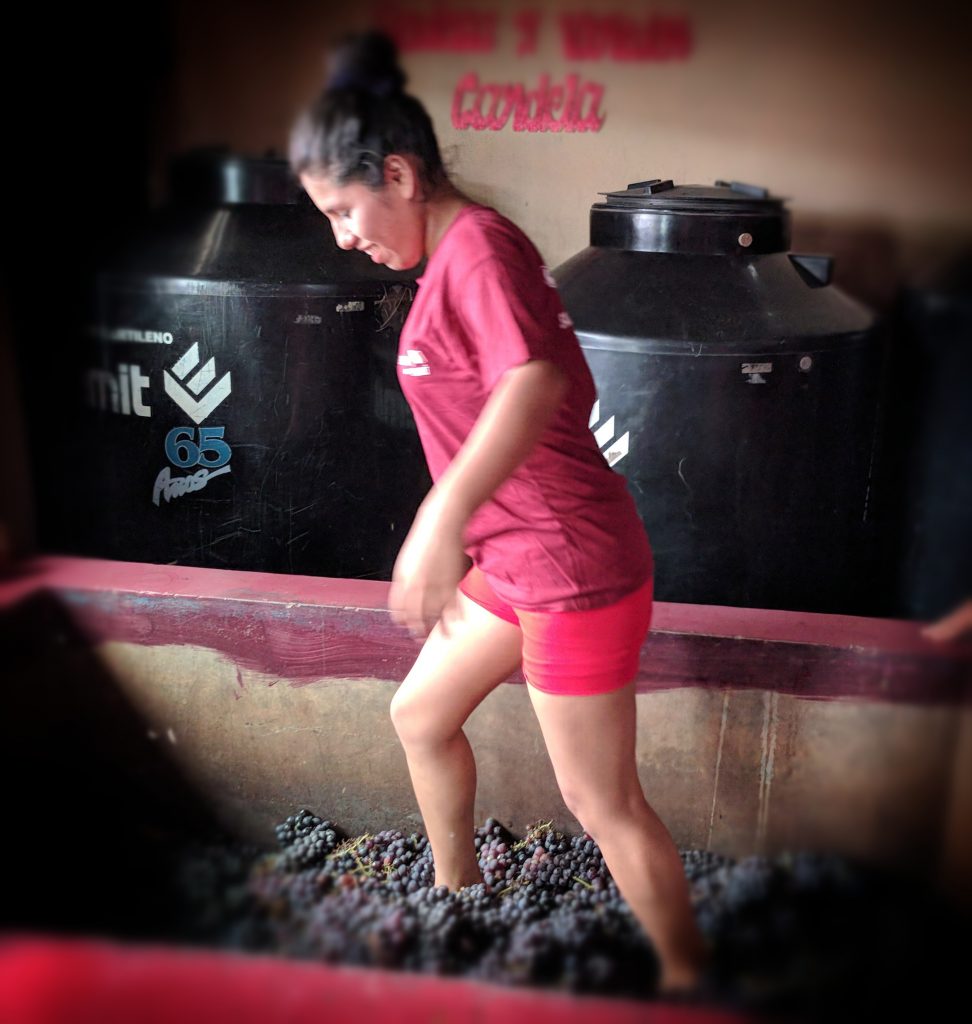
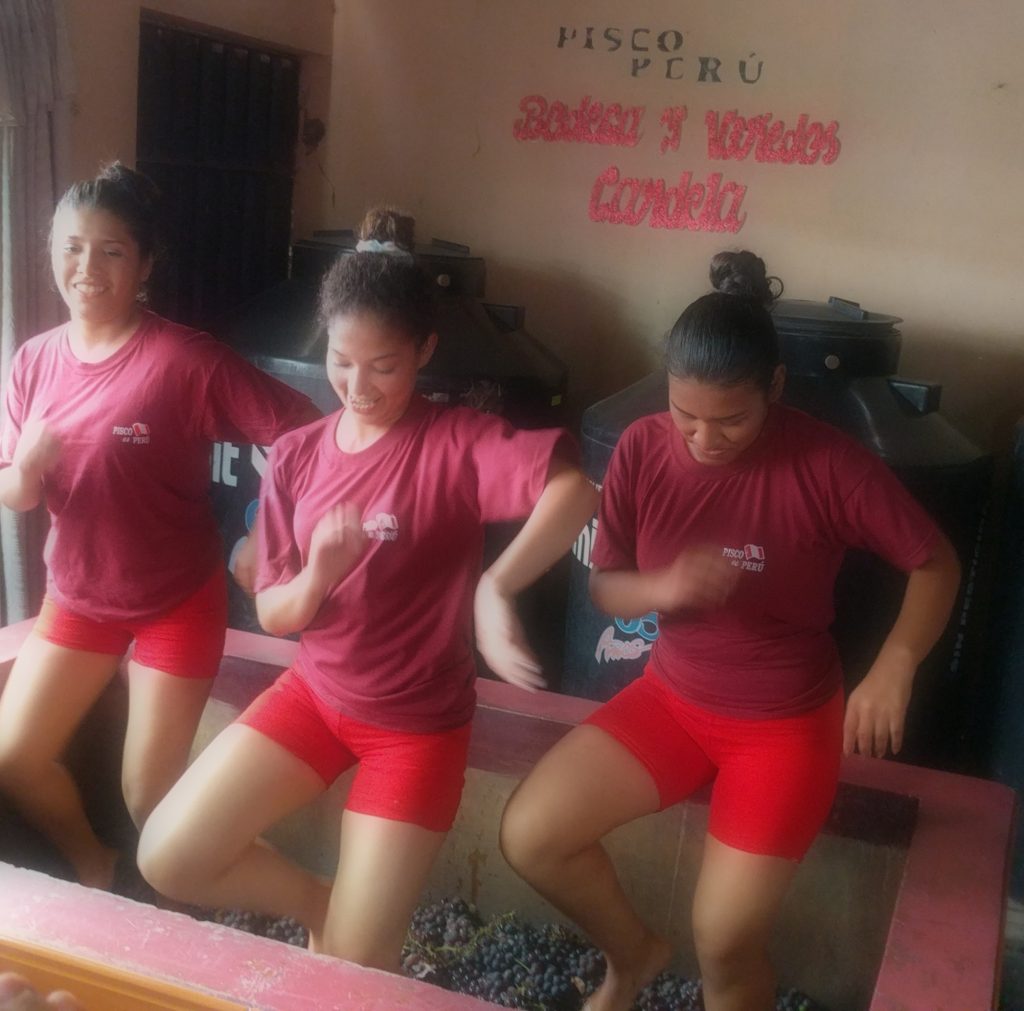
The crowd went wild for this rare site, and the wine store was selling a good number of bottles. Most of these were being cracked open right at the tables of the event, and few were waiting to take them home.
We were given tasting samples of the wines, and it was … well, not good.
Peru has a strange relationship with wine. Surrounded by superior wine-producing countries like Chile and Argentina, the harsh climates of Peru offer little in the way of proper terroir. The coast is bone-dry desert, and the interior turns into either festering rain forest or frigid, snow-capped mountains. There’s not much in between. The main wine-producing region of Ica has been promoted as being a serious contender, a place where someday some seriously good wines may be produced, but for now it’s mostly hype. As a result, Peruvians themselves have an interesting view of wine, and there’s no way to describe it but to use the snobbish term “unsophisticated.”
Peruvian wine is sweet. I mean, often, sickly sweet. One blogger wrote this off as part of the Peruvian sweet tooth, and while it’s true that Peruvians seem to amp up the sugar in their desserts, I’m not buying it. The sweetness of Peruvian wine is partly due to the grapes used — Borgoña is one of the only grapes that can grow here with any reliability — but then partly due to Peruvian obsession with making everything “on the cheap.” They can’t justify using a steel vat if they can buy a plastic cistern tank at the local hardware store for 1/100th of the cost.
Without much decent land to grow grapes, entire generations have grown up thinking Borgoña is a wine grape, and the country drinks the most sickeningly sweet, raisin-flavored syrups imaginable. Here we got a lesson in this problem close up: Borgoña can grow on your roof, so if you have enough of it, you can open a “winery.” Peru has no regulations on what is put on the label.
There’s also little sophistication in the winemaking processes used. The overall goal appears to be to process the wine as quickly as possible in order to get it to market. Local wines often go out with labels misspelled, bad corks, and highly inconsistent content. The result is sweet wine because they simply don’t bother to do anything else, and the Peruvian population has been calibrated to believe all wine is supposed to be sweet. The two Candela offerings, both marked “semi-seco,” were in fact on par with the sugar level of a Niagara icewine. When a Peruvian offers you a “dry” wine, it just means it has less sugar than a stack of syrup-soaked pancakes, but not as much as if you threw a bag of sugar on top of them.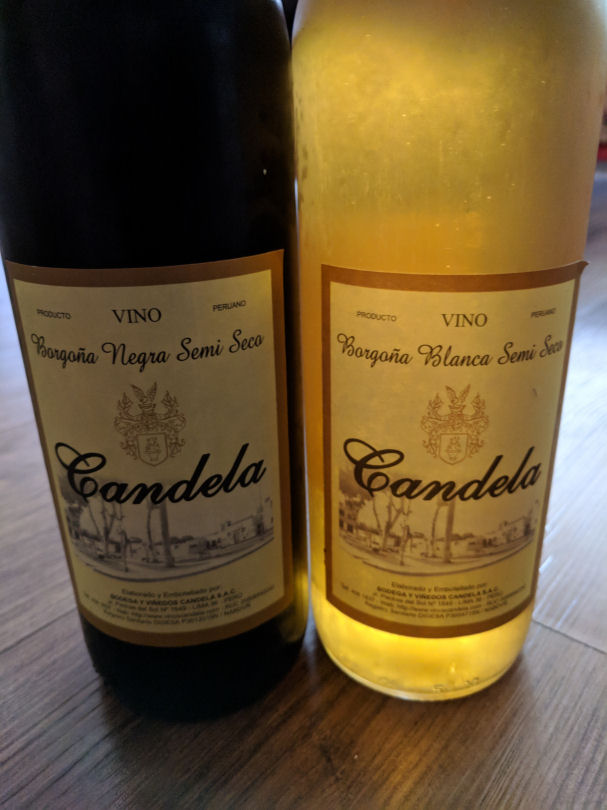
The main national producer here is Santiago Queirolo, and they pump out hundreds of thousands of syrupy garbage as fast as they can make the stuff. It’s priced at Thunderbird levels, so winds up on everyone’s table because Peru has not yet learned to go beyond its Third World culture when selecting wine. There’s little excuse for it, too, since Chile and Argentina have economies similar to Peru, and yet they take pride in their wine. Peruvians have no such pride in wine, and don’t even know they should.
So the Candela offerings were approached with the usual mental adjustments. They still failed to live up to expectations.
First up was the Candela Borgoña Negra Semi Seco NV, and yes, it tasted like raisins. There’s just no getting around that when you use grapes intended for eating to make table wine. As for the “semi seco” part, it’s just not true. This is sweet as hell, and I would put this at 100 g/l RS at least. I’m not kidding, this is what they think is semi-dry. The wine itself had both a bitter foretaste and aftertaste, and there was no structure to speak of. There were no perceptible tannins at all.
Candela Borgoña Negra Semi Seco NV
![]()
The white variant, Candela Borgoña Blanca Semi Seco NV, didn’t fair any better. It was slightly less raisiny, but only by a bit. Again, the raisin notes overpowered anything else, and given the terroir — someone’s roof — there are no other ways to introduce any additional nuances. I’d put this at less sugar, probably 65-80 g/l RS. Still sweet.
Candela Borgoña Blanca Semi Seco NV
![]()
So, yes, both wines landed a single star, alas. But the event itself was fun, filled with lively people and amazing music, and the food was good. The people were very proud of their wine, without a clue about how bad it was, so I won’t try to convince them otherwise.
But, wow, that was one batshit crazy winery visit.
Battle of the Budget German Reezies
Faced with a business trip to Texas — shudder — I opted to make the week a bit brighter by stocking up on some German rieslings to test against each other. I intentionally chose three budget reezies, each at $15 or less. These are readily available in the US, although would be treated as expensive “imports” if you try to get them in, say, South America. It’s nutty what I have to pay for a cheap riesling when I’m in Lima Peru.
The three Teutonic tipplers tasted were Dr. Herman “H” Riesling 2015 (Mosel), Blüfeld Medium Sweet Riesling 2011 (Mosel), and Schlink Haus
Riesling Spätlese 2013 (Nahe). I expected the Mosels to dominate the Nahe outside, but that’s not quite how things ended.
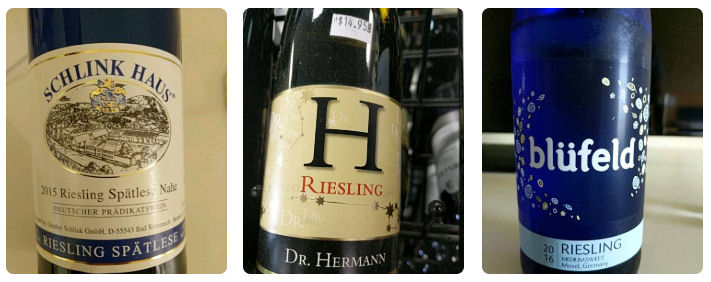
First out of the gate was the Schlink Haus Riesling Spätlese 2013 from Nahe. This was a fantastic hit, and not nearly as sweet as a standard spätlese. Still sweet enough to mark itself as a non-dry wine, with honey on the nose and gentle apple and green tea once past the choppers. Low acid, with no bite at all, but which worked very well with the mild sugar. Finish lasted forever; in fact, I think it was still going on months later. Highly recommended.
Schlink Haus Riesling Spätlese 2013
![]()
Next up was the Dr. Hermann “H” Riesling 2015. I anticipated this would be great. The German “doctor” branding is surprisingly reliable and not kitschy, and it comes from Mosel, so that would be a plus. Sure enough it landed its own 4.5 stars, matching the Schlink Haus. The color is golden and gorgeous. The nose of pear and spice almost invokes a gewurtztraminer, which happens often enough in that region. The flavors are soft green apple with just the right tartness, with a rush of other fruit following behind: pear, melon and lemon. Finish is a bit abrupt given the potent flavors, which probably cost it that final 1/2 star. But lovely, just lovely.
Dr. Hermann “H” Riesling 2015
![]()
At this point, I was certain we’d have an interesting trio, but none so far had hit the 5-star mark. I had low expectations for the everpresent “blue bottle” reez, since this bottling is typically an indicator of some low-grade stuff. The Blüfeld Medium Sweet Riesling 2011 wasn’t a terrible wine by any stretch, but it didn’t come close to the first two contenders. Surprisingly unsweet given the label, with an uncharacteristic minerality that rarely applies to a Qualitätswein riesling. It’s good, for sure, but the misleading expectations coat this a full star. Almost comes off as a blend, and did not at all feel like a typical Mosel offering. Still, not terrible and given the price, worth it. Just carry it out in a paper bag so no one sees that ridiculous bottle.
Blüfeld Medium Sweet Riesling 2011
![]()
If you’re a German Riesling fan, though, any of these are good picks. This also shows how you can’t go merely by the label to determine the final sweetness of what’s in the bottle, and doing tastings and knowing the brands helps quite a lot.
The Temperature of Your Wine Shop Matters
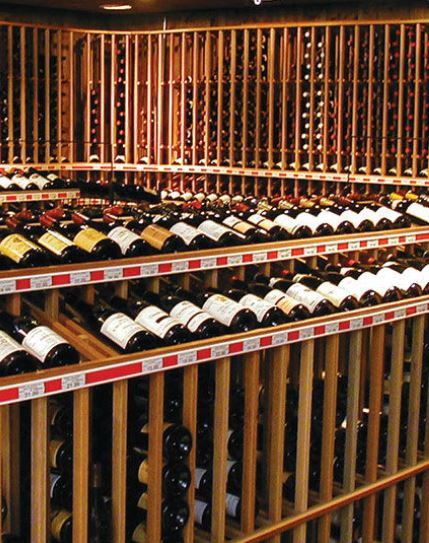 Recently I reviewed two vastly different wines that suffered from a similarly horrible problem: they tasted like utter garbage, as if someone had bottled the water used to put out a dumpster fire.
Recently I reviewed two vastly different wines that suffered from a similarly horrible problem: they tasted like utter garbage, as if someone had bottled the water used to put out a dumpster fire.
The first was a Trapiche Varietales Sauvignon Blanc 2011 from Argentina. I’d reviewed Trapiche before with mixed results (here, here and here), but the “Varietales” seemed like it might be interesting. The odd color appeared to hint that Trapiche was using SB to experiment with the “orange wine” idea, as the color was… well … orange. But the flavor was nothing less than horrid. It reeked of gasoline of prune juice. Orange wine has a quirky flavor profile, with some saying it invokes wood varnish, but this was not that. Something entirely different, and entirely horrible.
The next was another Argentino, this one La Rural Pequeña Vasija Malbec Syrah 2017. This one smelled and tasted exactly like burned pea soup, which if you’ve ever burned pea soup you know it not only ruins the smell of your house for a week, but you have to throw the pot out afterward because there’s no getting rid of the taste.
A day later I realized something. The two wines could not be more different, other than their country of origin. But clearly Argentina produces fantastic wine, so that’s not it. Instead, I remembered they were both impulse buys at the large Peruvian Sam’s Club knockoff, Makro. Makro has a small and unimpressive wine section that usually features the syrupy garbage that passes for wine here, often at a few bucks a bottle, but with a few occasionally nice (if also low priced) sparkling wines. It’s not a place you can rely on to buy anything of value, but I had just gotten off a stomach bug and hadn’t tasted anything in weeks, so I was not thinking straight. I bought the Trapiche and the Pequeña Vasija together.
I also now remember how irritating it is to shop at Makro because the place isn’t air-conditioned. It’s a giant warehouse store — again, much like Sam’s Club — but they don’t have the money to cool it properly, so the inside runs at least 80-85 degrees on cool days. Often, when shopping, I have to dip into the employees-only frozen locker just to cool off before I can finish shopping there. This same problem is noticeable at any of the typical “liquor stores” in Peru, which nearly never have A/C, and have wines sitting on the shelves often for years. The two higher end wine shops, Almendariz and Via Venum, do it right: they are properly air-conditoned, have chilled wine fridges for some ready-to-drink whites, and a walk-in “cellar” with temperature controls for the reds. But anywhere else, you’re likely to get wine that’s been exposed to 90+ degrees F for days, weeks or even years.
That has to be the explanation. Both the Trapiche and the Pequeña Vasija were probably sitting in the Makro shelves for weeks, at least, at impossible temperatures. You can’t be sure, either, how they were shipped; often wine is delivered to such store in the back of open pickup trucks, driving under the hot Peru sun.
Americans may not have this problem, but they need to watch out for it anyway. If the store’s temperature isn’t right for storing wine, you shouldn’t buy your wine there. You’re likely to find yourself drinking burned pea soup.
First Wine Tasted in 2018 Nails Five Stars
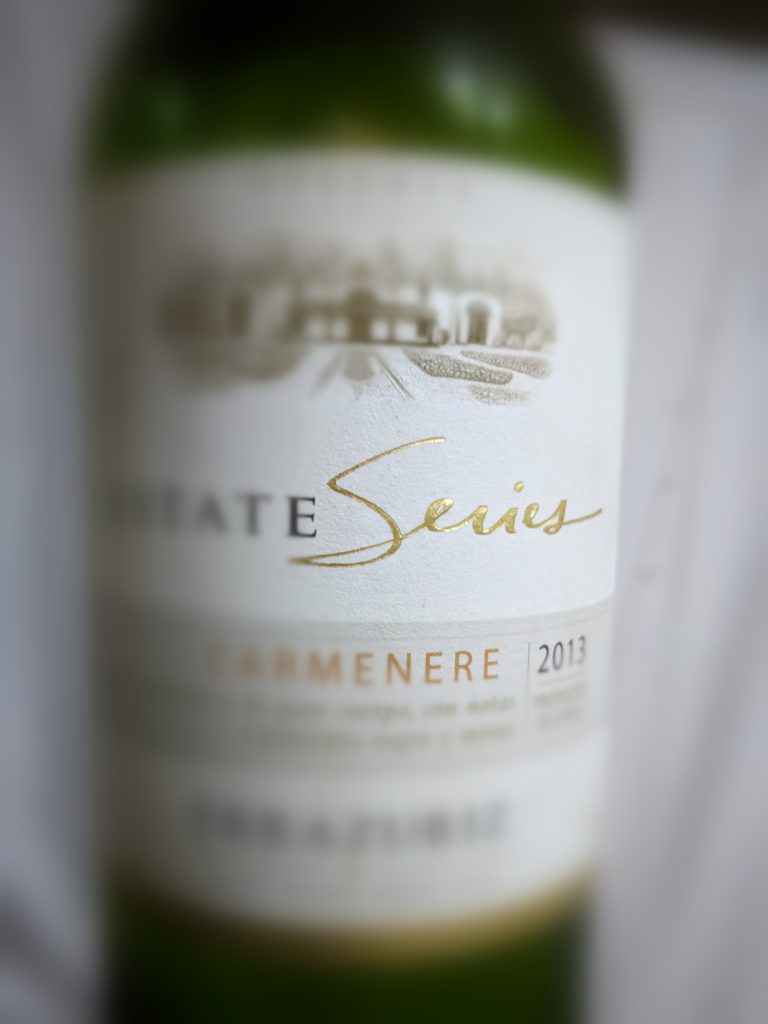 It was slow going last year, with a struggle to find some 5-star winners until mid-year, but 2018 hit the road running. The very first wine tasted nailed a coveted cinco!
It was slow going last year, with a struggle to find some 5-star winners until mid-year, but 2018 hit the road running. The very first wine tasted nailed a coveted cinco!
Meet the Errazuriz Estate Series Carmenère 2013 from Chile, a budget carmy that will absolutely defy your ability to suss out the price by taste alone, and which truly proves we continue to live in the Golden Age of Wine. No longer must you worry about spending a fortune to have an outstanding glass, and this Carmenère proves it.
Here, smoke is the leading note, but not so much that you feel you’re drinking this over a barbecue pit, so don’t worry. It’s subtle, but definitely makes itself known in both the nose and tongue. From there, it’s fruity goodness with low sugar, all dark berries and silky smooth tannins. Paired well with a spicy Italian dish, but drank equally well by itself during another occasion.
Learn more by visiting the Errazuriz website here.
![]()
Winepisser Best Wine of 2017: Alvear Pedro Ximénez de Añada 2014
 The third annual Winepisser Best Wine Award goes to Alvear’s Pedro Ximénez de Añada 2014, a fantastic dessert wine that my original review boldly claimed didn’t need dessert because it was the dessert.
The third annual Winepisser Best Wine Award goes to Alvear’s Pedro Ximénez de Añada 2014, a fantastic dessert wine that my original review boldly claimed didn’t need dessert because it was the dessert.
Let’s get this out of the way first, as I am sure some wine snobs are shocked — shocked, I say! — that a dessert wine could beat out a fantastic assortment of reds and whites tasted over the course of an entire year. I am not a fan of sweet wines unless they are specifically intended for dessert or as an aperitif. I prefer my day wines dry, and my after-dinner wines any way they might best accent the plate I just ate. I am a fan of icewine, for sure, as well as port. But if I pick up a bottle of Peruvian malbec and find it tastes like maple syrup, I will gag, spit and write a scathing review, in that order.
There’s a place for sugar. I get that.
But good lord, man, this Pedro Ximenez is just astounding. The sugar content is insane, for sure, but never have I had a wine this sweet that avoided all the usual tropes, and one you’d be hardpressed to label “saccharine” or “cloying.” Yes, you’ll have to drink this after dinner. Yes, you will have to sip it (it’s packing a whopping 17% alcohol. Yes, you’ll have to break out the tiny glasses. No, you won’t want to eat a white cake with this at the same time.
If you do it right — serve it after a dinner, especially a meaty one, and serve it by itself — your guests will be enthralled. They will ask you what it is, where you bought it, and how many virgins you threw into a volcano to make it. It’s that good.
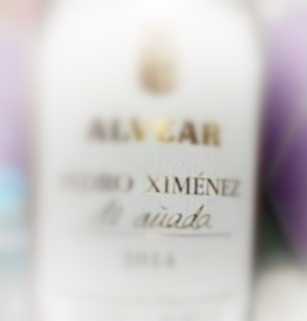
When I encounter a glass like this, my first tendency is to bark, “Que brujeria es esta?” In this case, we must go to the Alvear website to glean the details of said witchcraft:
“The name tells you all about this wine’s origin: this sweet young wine is obtained through drying the Pedro Ximenez grapes on mats in the sun. It is the best way of bringing an intense Andalusian summer sun to your table from a single harvest. The wine is aged in the traditional earthenware jars, tinajas, where it is left for 12 months.”
Despite the poor choice of wording on the Alvear website indicating it tastes like raisins, this is not quite true. I am keenly aware of sweet wines that make me suspect they were made by Sun-Maid, and this wine is not cursed with this problem. The flavors are not raisiny, but something quite different. Alvear isn’t kidding when they say it has a slight citric after-kick; it’s very faint, but totally changes the overall flavor. Fantastic!
You can read the original review of this fantastic offering from Alvear here. To visit the Alvear website, go to www.alevear.es, but you can find the Pedro Ximenez Anada page here. To see who the final contestants were in 2017’s Winepisser Best Wine race, click here.
To read who won the 2017 Worst Wine Award, click here.
Click here for the 2015 Winepissser Best Wine winner, and for the 2016 Best Wine Award, click here.
Quick Cuttings